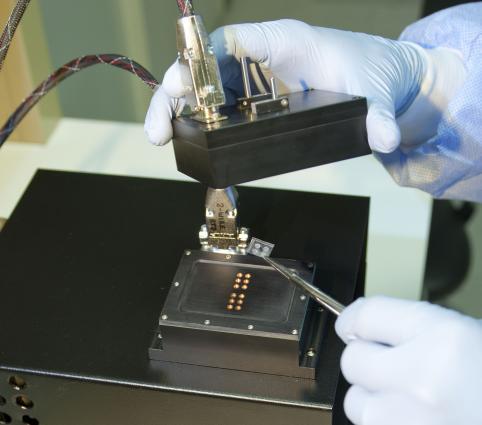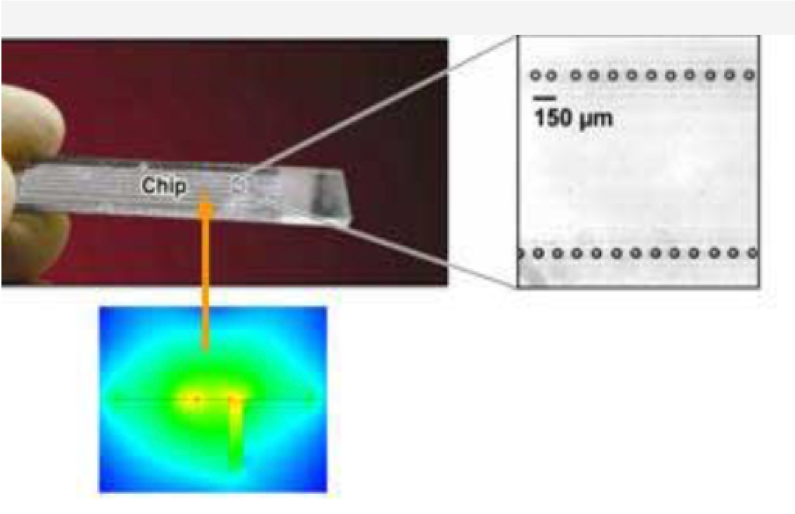The science of microfluidics has grown exponentially, and the benefits can be seen across a variety of scientific disciplines. Microfluidic device loosely describes the new generation of instruments that mix, react, count, fractionate, detect, and characterize complex gaseous or liquid-solvated samples in a micro-optical-electro-mechanical system (MOEMS). Despite the great capabilities of the MOEMS fluidic systems, current MOEMS systems have the problem of heating not only the chemical reactor volumes within their channels, but also heating the entire substrate which can lead to poor thermocycling and insufficient nucleic acid amplification. The following inventions from LLNL describe solutions to these heating problems.
Laser heating of aqueous samples on a micro-optical-electro-mechanical system (LLNL Internal Case # IL-11719, US Patents 8,367,976; 8,610,032)
Researchers at LLNL have developed an instantaneous sample heating method to efficiently deposit thermal energy into a continuous stream or segmented microdroplets on a MOEMS device using an optimally low energy, commercially available CO2 laser. The device uses an ideal wavelength (absorption in the far infra-red (FIR) region (λ=10.6 μm)) to instantaneously heat fluidic partitions. The wavelength is absorbed by water molecules and waste little energy because, unlike typical PCR heating elements, the device itself is not heated by the laser. Instead the aqueous solution directly absorbs the heat.
This technology is a major improvement over current microfluidic channel heating methods. The use of efficient optical heating elements increases precision and provides users with a cost effective, high-throughput PCR device. It cuts processing time by an order of magnitude resulting in truly real time PCR, in vitro protein translation, immunoassay analysis, etc.
The figure shows a representative schematic of the technology. This method employs a laser and lens that transmit light into the microfluidic channel from above or below. The lens can be circular for spot-focused heating, or cylindrical to focus the beam on a line overlaying the entire channel for simultaneous heating of the aqueous contents of the entire channel.
Instantaneous in-line heating of samples on a monolithic microwave integrated circuit microfluidic device (LLNL Internal Case # IL-11981, US Patent 10,123,380)
LLNL has developed a new technology that provides a method for near-instantaneous heating of aqueous samples in microfluidic devices. The technology relates to a heating method that employs microwave energy absorption from a coincident low power Co-planar waveguide or microwave microstrip transmission line embedded in a microfluidic channel to instantaneously heat samples. The method heat samples in a focused area within a microfluidic channel on miniaturized chips. Aqueous solution microwave heating allows extremely fast heat transfer for both heating and cooling.
The LLNL device and method provide a major advantage over current heating methods such as joule-heating from trace resistors which are time-consuming and provide an associated whole device heat build-up. The LLNL microwave heating method provides focused-area heating on an instantaneous time scale. The LLNL method provides a cost incentive by cutting processing times by an order of magnitude. This time savings makes popular on-chip processes such as PCR, in vitro protein translation, immunoassay analysis, etc.
Microwave Heating of Aqueous Samples on a Micro-Optical-Electro-Mechanical System (LLNL Internal Case # IL-11966, US Patents 8,969,767 and 9,313,833)
This technology describes a method for performing immediate in-line sample heating to promote the required chemical reactions for amplification, activation, or detection, depending on the thermodynamics of the particular assay involved. The basis of this technology is a method that employ microwave energy absorption to instantaneously heat fluidic partitions without heating the device itself or any oil, or entrapped air. With this invention little energy is wasted heating the device and instead is absorbed heating the aqueous solution within the microfluidic device’s chambers, channels, or reservoirs. This will allow the most efficient, fastest, and best method for energizing chemical reactions in microfluidics devices.
Additionally, this system allows for optical addressability of the cavity or waveguide, which allows fluorescence detection of temperature, pH, nucleic acid amplification for PRC, or direct optical observation of cell lysis, sedimentation, and other signals and observations under test for the real-time microfluidic device.
The figure shows the method for the instantaneous heating of droplets, slugs, or streams in a microfluidic device utilizing microwave energy.
- Biomedical, forensic, and defense applications
- Identifying, tracking, and monitoring infectious disease outbreaks and bio-threat agents
- Automated processing, amplification, and detection of host or microbial and viral DNA or RNA
- High-throughput genetic screening for point-of-care diagnostics or forensics
- Cell cytometry or viral cytometry
- Food and Beverage
- Automated food testing for bacterial or viral contamination
- Water and milk supply testing
- Microscale chemistry
- Chemical processing and assembly of novel nano-structures, probes, and other endothermic reaction products of interest




